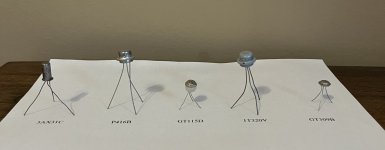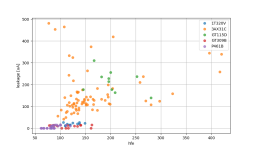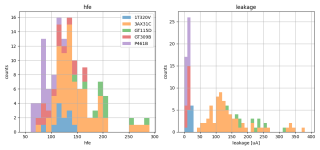PedalBuilder
Well-known member
I've had a bunch of fun lately building (and playing through) silicon fuzz pedals, so I decided I'd branch out and have some fun with germanium, too. I picked up several different models of Soviet transistors from alexer1 on eBay and on a whim also bought a set of 100 Chinese 3AX31C germanium transistors from UM2part on AliExpress. All of them arrived surprisingly fast (10 days from China and 27 days from Ukraine despite an ongoing war). After they arrived, I tested them with my trusty Peak DCA55, and recorded the results.
First, a picture of the happy Germanium Family:

Now on to the overview.
3AX31C - Chinese PNP germanium transistor in a TO-1 or similar package. The ones that I received appeared to be an assortment of different lots, as there were several minor variations of the markings on the packages and the legs had varying degrees of oxidation. I paid ~$40 for 100 transistors shipped from Shanghai to the US. Out of the 100 transistors that I received, 1 was dead (it appeared to the DCA55 as a common anode diode network), 16 had leakage >500µA, and 9 had extremely low gains (hFE <10). The remainder had hFE ranging from 77-420, with an average hFE of 164 and an average leakage of 160. To me, the 3AX31C seems to have more in common with western transistors than the Soviet ones—the pinout is the usual EBC, the collector isn't connected to the case, and the transistors have more leakage. How will that translate sonically? Looking forward to finding out. Depending on how these work out, I might try a box of the 3BX31B, an NPN cousin of the 3AX31C, which the same seller had in stock.
P416B - Soviet PNP germanium transistor in what I'd describe as a "large UFO" package. These all had really low leakage; 11 out of the 22 measured as having 0 leakage and none with more than 17µA leakage. (The DCA55 does not seem to be able to detect leakage below 9µA, so they all probably have some leakage, just not very much.) All of the transistors that I received tested as functional, with hFE ranging from 62 to 120 and an average hFE of 86.
GT115D - Soviet PNP germanium transistor in what I'd describe as a "small UFO" package. These also had a some sort of plastic insulator at the bottom of the transistor body; not sure why. These were largely higher gain and leakier than the other Soviet transistors; the hFE ranged from 146 to 280 and averaged 203. Leakage ranged from 139µA to 311µA, with an average of 214µA.
1T320V - Soviet PNP germanium transistor, the military version of the GT320V, in the large UFO package. Higher gain than the P416B, but still very low leakage, with none measuring over 27µA. Gains ranged from 82 to 149 with an average of 120, and leakage ranged from 0 to 27µA, with an average of 19µA.
GT309B - Soviet PNP germanium transistor in the small UFO package. Similar gain and lower leakage relative to the 1T320V, with an average gain of 116 and an average leakage of ~11µA. Gains ranged from 78 to 163 and leakage from 0 to 15µA.
Individual measurements are below for those interested:
First, a picture of the happy Germanium Family:

Now on to the overview.
3AX31C - Chinese PNP germanium transistor in a TO-1 or similar package. The ones that I received appeared to be an assortment of different lots, as there were several minor variations of the markings on the packages and the legs had varying degrees of oxidation. I paid ~$40 for 100 transistors shipped from Shanghai to the US. Out of the 100 transistors that I received, 1 was dead (it appeared to the DCA55 as a common anode diode network), 16 had leakage >500µA, and 9 had extremely low gains (hFE <10). The remainder had hFE ranging from 77-420, with an average hFE of 164 and an average leakage of 160. To me, the 3AX31C seems to have more in common with western transistors than the Soviet ones—the pinout is the usual EBC, the collector isn't connected to the case, and the transistors have more leakage. How will that translate sonically? Looking forward to finding out. Depending on how these work out, I might try a box of the 3BX31B, an NPN cousin of the 3AX31C, which the same seller had in stock.
P416B - Soviet PNP germanium transistor in what I'd describe as a "large UFO" package. These all had really low leakage; 11 out of the 22 measured as having 0 leakage and none with more than 17µA leakage. (The DCA55 does not seem to be able to detect leakage below 9µA, so they all probably have some leakage, just not very much.) All of the transistors that I received tested as functional, with hFE ranging from 62 to 120 and an average hFE of 86.
GT115D - Soviet PNP germanium transistor in what I'd describe as a "small UFO" package. These also had a some sort of plastic insulator at the bottom of the transistor body; not sure why. These were largely higher gain and leakier than the other Soviet transistors; the hFE ranged from 146 to 280 and averaged 203. Leakage ranged from 139µA to 311µA, with an average of 214µA.
1T320V - Soviet PNP germanium transistor, the military version of the GT320V, in the large UFO package. Higher gain than the P416B, but still very low leakage, with none measuring over 27µA. Gains ranged from 82 to 149 with an average of 120, and leakage ranged from 0 to 27µA, with an average of 19µA.
GT309B - Soviet PNP germanium transistor in the small UFO package. Similar gain and lower leakage relative to the 1T320V, with an average gain of 116 and an average leakage of ~11µA. Gains ranged from 78 to 163 and leakage from 0 to 15µA.
Individual measurements are below for those interested:
| 3AX31C | 3AX31C(cont) | P416B | GT115D | 1T320V | GT309B | ||||||||||
|---|---|---|---|---|---|---|---|---|---|---|---|---|---|---|---|
| hFE | Leakage | hFE | Leakage | hFE | Leakage | hFE | Leakage | hFE | Leakage | hFE | Leakage | ||||
| 420 | 339 | 143 | 112 | 120 | 10 | 280 | 139 | 149 | 23 | 163 | 15 | ||||
| 417 | 258 | 137 | 93 | 112 | 14 | 252 | 237 | 138 | 20 | 161 | 0 | ||||
| 396 | 345 | 137 | 84 | 101 | 14 | 209 | 164 | 138 | 27 | 141 | 14 | ||||
| 323 | 159 | 136 | 128 | 100 | 17 | 202 | 177 | 134 | 20 | 140 | 14 | ||||
| 297 | 124 | 136 | 166 | 96 | 10 | 200 | 256 | 125 | 25 | 134 | 9 | ||||
| 280 | 108 | 135 | 67 | 93 | 15 | 196 | 228 | 120 | 16 | 128 | 10 | ||||
| 270 | 125 | 134 | 164 | 90 | 15 | 196 | 214 | 119 | 16 | 116 | 0 | ||||
| 265 | 237 | 133 | 117 | 88 | 0 | 182 | 236 | 114 | 19 | 115 | 13 | ||||
| 258 | 211 | 133 | 168 | 88 | 0 | 167 | 311 | 110 | 13 | 111 | 0 | ||||
| 205 | 419 | 132 | 83 | 86 | 0 | 146 | 178 | 110 | 11 | 103 | 0 | ||||
| 204 | 182 | 132 | 135 | 86 | 14 | 106 | 27 | 94 | 10 | ||||||
| 199 | 110 | 131 | 103 | 86 | 10 | 82 | 0 | 88 | 13 | ||||||
| 197 | 113 | 131 | 89 | 84 | 10 | 86 | 14 | ||||||||
| 195 | 199 | 127 | 71 | 82 | 0 | 81 | 13 | ||||||||
| 195 | 143 | 127 | 112 | 81 | 10 | 78 | 13 | ||||||||
| 194 | 155 | 127 | 114 | 80 | 0 | ||||||||||
| 189 | 128 | 126 | 218 | 74 | 0 | ||||||||||
| 182 | 133 | 125 | 97 | 74 | 0 | ||||||||||
| 174 | 82 | 125 | 324 | 68 | 0 | ||||||||||
| 174 | 183 | 124 | 107 | 67 | 0 | ||||||||||
| 167 | 128 | 122 | 66 | 63 | 0 | ||||||||||
| 166 | 109 | 121 | 150 | 62 | 0 | ||||||||||
| 165 | 133 | 119 | 102 | ||||||||||||
| 164 | 85 | 118 | 333 | ||||||||||||
| 161 | 374 | 118 | 118 | ||||||||||||
| 160 | 145 | 117 | 243 | ||||||||||||
| 155 | 131 | 114 | 107 | ||||||||||||
| 154 | 108 | 114 | 77 | ||||||||||||
| 154 | 264 | 112 | 72 | ||||||||||||
| 152 | 143 | 111 | 50 | ||||||||||||
| 151 | 113 | 109 | 141 | ||||||||||||
| 151 | 107 | 108 | 465 | ||||||||||||
| 148 | 133 | 107 | 42 | ||||||||||||
| 148 | 128 | 102 | 84 | ||||||||||||
| 147 | 118 | 95 | 56 | ||||||||||||
| 144 | 176 | 90 | 454 | ||||||||||||
| 144 | 121 | 77 | 481 |
Last edited:



